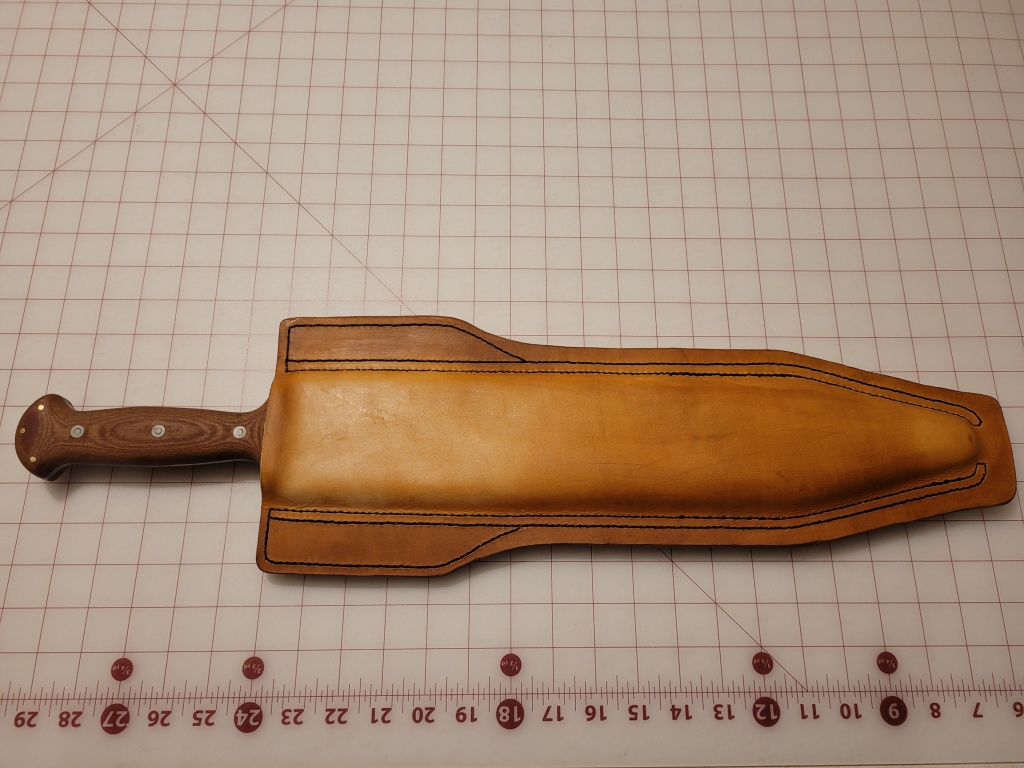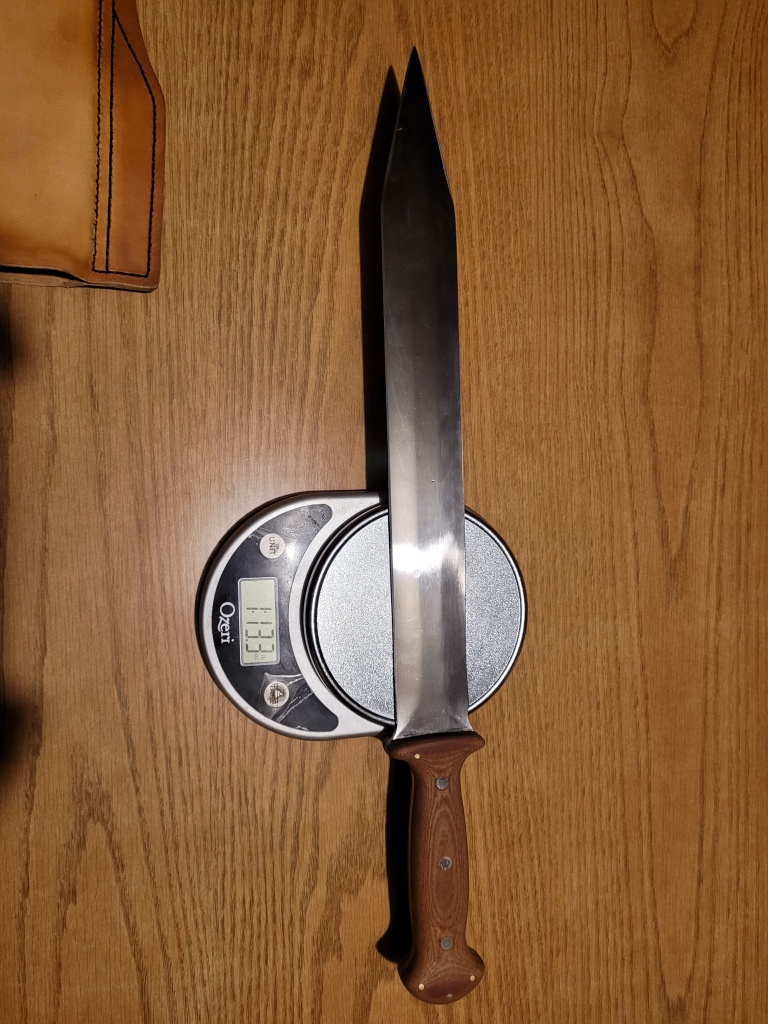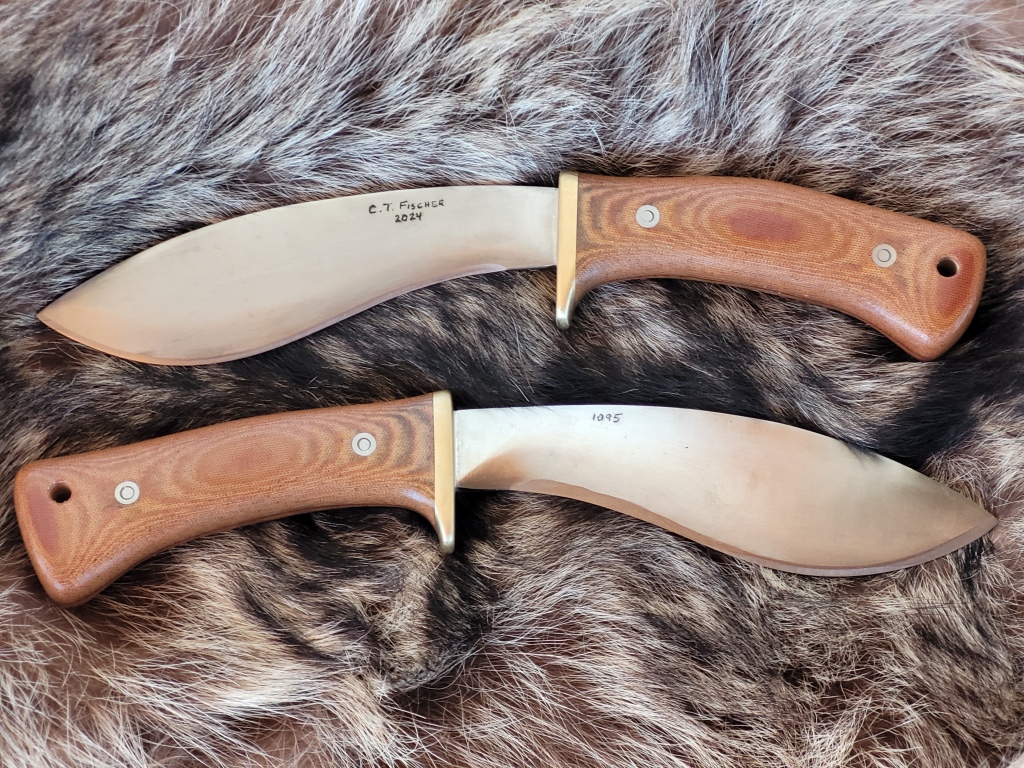
This is a new design, inspired by the PTS survival theme. There are some things we liked better about the older PTS knife, but getting them all to flow into a functional system was baffling me.
Anyway, throwing in the fact that in a real longer-term survival situation, preparing food is just a bit behind shelter and fire in importance, I also wanted something that would be more efficient than the recurve bolo blade for cutting board work.
This knife is a bit heavier than the PTS knives at 12.8 ounces. However, that is deceptive at first glance, because the high-carbon sawmill-blade steel on this individual is about 20% thicker than what we have been using on the PTS knives. So the corrected comparison would be a PTS knife weighing 11 ounces, compared to the Chef at 12.8. So the overall weight gain is about 16%, as the design stands.
This sheath weighs about 7.1 ounces (around 0.6 ounces heavier than the new model PTS Bush Knife sheath), bringing the total to 19.9 (compared to 17.5 ounces for the thickness-corrected New Model PTS knife) according to my scale. And YES, I put the quick-detach belt-loop on this sheath, too. Any blade this big needs to be quick-on quick-off, without forcing one to rebuild his belt setup.
So, what do we gain for that extra 2.4-or-so ounces?
–better cutting board performance
–more pointy tip, yet still strong
–simpler cutting geometry (recurves are quirky compared to straight edges)
–more grip for larger hands (users with man-size hands often find the new PTS knife to be a bit scant on handle)
–there is less taper to the handle than on the new PTS Bush Knife handle, so it is more comfortable for slicing and carving tasks.
–while there is not a “guard” per se, the blade is a full half-finger thickness wider than the front of the handle, providing ample tactile awareness of where the sharp part starts, and minimizing accidental slippage.
–better sheath interface, retention, and resistance to overpenetration of the blade into the welt and stitching, compared to the original PTS Bush Knife sheath.
So compared to a regular chef’s knife, what is different here? First of all, edge strength. Like the PTS Bush Knives, this one is designed as a high-impact, durable wood-cutting tool. Compare it more to a light cleaver.
So, why not just use a cleaver? Excellent question.
–cleavers usually have wider blades without effective points needed for many woodcraft and survival jobs. Cleavers tend to work fairly well as hatchets, but are shorter and heavier, by comparison.
–the wider blade on a cleaver gives a definite disadvantage in terms of torsion mechanics. It is a good chopper, but a poor carving tool. In prolonged use, it creates more stress to the hand and wrist.
So what are the cons to this design?
–less weight forward = less log-chopping power toward the tip. (However, it also means an increase in tip velocity with a wrist-flick chopping motion which is used in slashing vines and twigs.) So this knife, compared to the PTS Bush Knife, leans away from the “axe” toward the “machete.” So based on your needs, this might go either “pro” or “con.”
–the sheath is slightly more complex. It operates on the same principles as the new PTS Bush Knife sheath. And unlike the original PTS sheath, it doesn’t scare me.
–less-useful as a draw-knife. (If it’s all I had, I might consider binding a split-stick handle over the point, using wire, strong cord, sinew, rawhide, etc. to keep it tight?) Basically, either the old or new model of the PTS Bush Knife is a better drawknife than the Chef’s. What’s good for the goose may not always be good for the gander? If the squaws ask for both designs, they may have good reasons.
If you really CANNOT TOLERATE an extra 2.4 ounces, it would be quite possible to grind away that much metal and/or micarta. But please, let’s do that BEFORE making the sheath! (Ideally, before assembling the handle.) What part would you wish to reduce?
What are your thoughts? Which blade type would you prefer to have as your one-and-only “big blade” for light, rapid travel and campcraft under austere circumstances?















